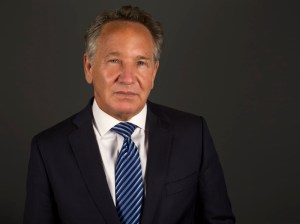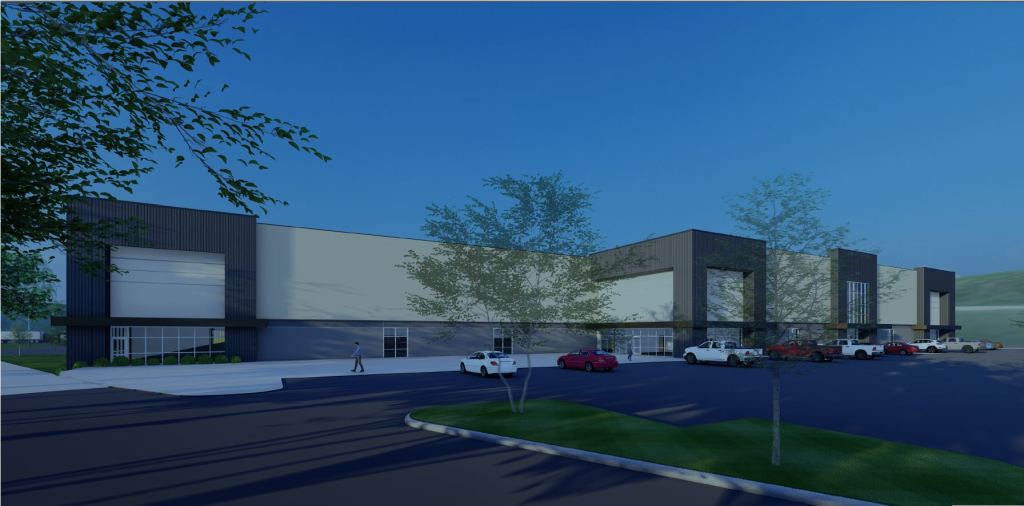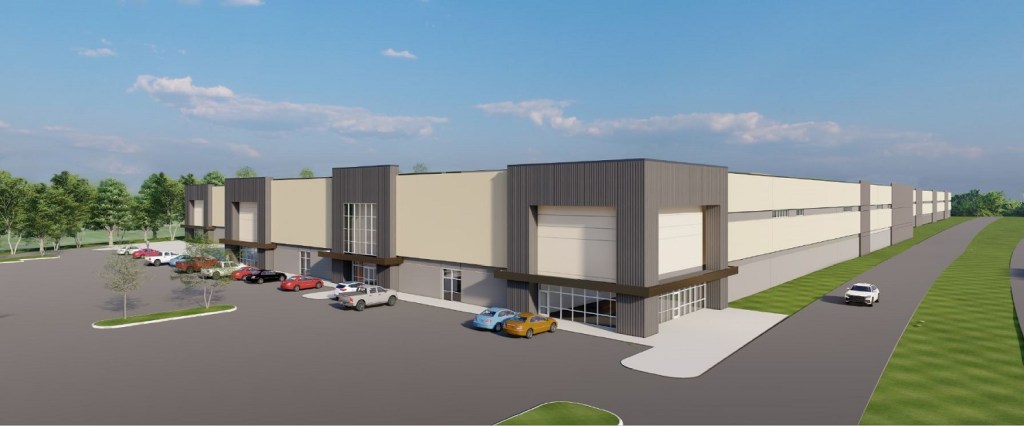From Power Plant to Industrial-Strength Campus in PA
How a brownfield site on a key corridor is getting new life as a manufacturing hub.
The Portland Generating Station in Upper Mount Bethel, Pa., opened in 1958 and operated as a coal-fired power plant until 2015 when the facility’s boilers were shut down under a court agreement with then-owner NRG Energy. The reason? Pollution and environmental concerns. Since then, the plant remained dormant, “as an eyesore on the Delaware River,” according to Lou Pektor, president of River Pointe Commerce Park, the company that took over the 162-acre site and the adjacent 640 acres in 2021 with the intent to build a massive industrial campus over the next decade.

The project site has varying topography, which will be used as an asset to effectively tuck larger footprint structures with varying heights into the side of rolling hills while minimizing view shed impacts. Image courtesy of River Pointe Commerce Park
The site has been undergoing substantial remediation work, beginning with the demolition of the former power plant—specifically, the removal of 700,000 square feet of post-industrial infrastructure, including two massive 480-foot-tall smokestacks that tower over the Delaware River and that once emitted sulfur dioxide into the skies over the Lehigh Valley and Northwest New Jersey.
Commercial Property Executive asked Pektor to expand on the potential economic impact of the project on the Lehigh Valley area. All planned buildings still need final land development authorization from the Upper Mount Bethel Township.
What inspired the River Pointe Commerce Park project? What is the vision behind this transformation?

The master-planned industrial park has many eco-centric and self-sustaining features not typically found in many industrial parks, according to Pektor. Image courtesy of River Pointe Commerce Park
Pektor: Several factors inspired this project.
One is its strategic location. Located along Interstate 80 at the Pennsylvania-New Jersey border in Upper Mount Bethel, River Pointe Commerce Park and River Pointe Commerce Park East can reach one-third of U.S. consumers within a one-day drive. It is also within 70 miles of major international airports and prominent ports.
Known as a ‘great place to live, work, play and learn,’ this site offers the combination of a strong regional labor market, established workforce development opportunities, exceptional quality of life, highly ranked health-care access and more than a dozen universities, all serving as key elements that add to the unparalleled attributes of this site.
Another factor is power. Because of the site’s history as a power plant, River Pointe can provide large volumes of power with direct connection to transmission at both 115 kV and 230 kV levels. This allows the park to cater to the high-energy demands of more complex industries than the typical warehouse.
READ ALSO: Manufacturing’s Comeback Boosts Industrial Space Demand
We also had an expansive industrial footprint and allowable heights. River Pointe Commerce Park and River Pointe Commerce Park East combined will make up more than 8.1 million square feet of industrial footprint across 16 buildings of varying sizes on 800-plus acres. The scale and array of square footage, and allowable heights of up to 100 feet enable the park to cater to a vast set of users and to create an ecosystem.
Additionally, utilizing the existing Norfolk Southern Rail that once hauled in coal to the power plant on East, River Pointe can attract users with diverse distribution needs. Furthermore, River Pointe Commerce Park benefits from the Local Economic Revitalization Tax Assistance Act. LERTA phases in real estate taxes on the improvements made to the property over 10 years, whereby taxes are increased by 10 percent each year until the fully assessed value is reached in year 11.
[…] River Pointe Commerce Park stands as a beacon of progress in revitalizing manufacturing in both the Lehigh Valley region and the U.S. as a whole. In recent years, the Lehigh Valley region has demonstrated robust growth in manufacturing, now constituting nearly 20 percent of its GDP. The project will contribute significantly to economic growth and stability by generating over 4,000 good-paying manufacturing jobs and creating a much-needed source of tax revenue for the region.
What does it take to convert this former brownfield site into a risk-free area? What methods will be used/have been used at River Pointe Commerce Park?
Pektor: River Pointe Commerce Park is dedicated to undergoing site remediation through the Act 2 program to turn the former power plant into an economic engine. Countless engineers and environmental experts have been brought on for in-depth site investigations and environmental analysis to develop the remediation, demolition and environmental preservation plan for the site’s reuse. Additionally, River Pointe Commerce Park is working closely with all related government entities to ensure all remediation requirements are adhered to and met.
What’s most challenging about this phase of the transformation?
Pektor: The most difficult part of the transformation at the former Portland Generating Station is the amount of time environmental preservation, remediation and demolition efforts take. River Pointe Commerce Park works with several experts to conduct extensive studies that guide the remediation approach. The 162-acre site of the former power plant is the only portion of the 800-acre project that must undergo remediation through the Act 2 program.
The project site has varying topography, which will be used as an asset to effectively tuck larger footprint structures with varying heights into the side of rolling hills while minimizing view shed impacts. Building layouts are located to maximize the preservation of open space and are respectful of the natural environment, its constraints and characteristics. Instead of creating a cleared site with a blank slate to build from, existing vegetation and natural habitats have been incorporated into the master plan designs and building locations. Existing old-growth wooded areas will serve as additional visual buffering. Architect-driven façade details on buildings will also ensure aesthetics are incorporated versus the typical construction of white industrial ‘boxes’ for manufacturing.
How long until the area is risk-free for the new use?
Pektor: This 162-acre site that houses the former coal plant and requires remediation will be subdivided to accommodate a well-planned development timeline. This site will be developed in phases and subdivided to accommodate the planned phases. Remediation of the southern portion of the site under the Act 2 program will be accomplished through soil capping—a combination of building construction and a layer of fresh soil where building and parking areas are not planned. The current development timeline estimate is for the areas requiring remediation to be constructed by the end of 2025.
Did you access any governmental cleanup grants for this project?
Pektor: In 2022, the Redevelopment Assistance Capital Program awarded River Pointe Commerce Park $500,000 for remediation, removal and disposal of asbestos-containing materials at the former power plant, in addition to demolishing one of the decommissioned boilers on the site. River Pointe Commerce Park is still exploring other governmental grants to assist with financing its cleanup efforts.
In October, the project received conditional use approval to develop a 1.5 million-square-foot building. What exactly does conditional use approval mean for River Pointe Commerce Park and what is the next step?
Pektor: Before the conditional use approval, the project had proposed constructing three separate buildings totaling more than 1.6 million square feet. With conditional use granted, it now has the option to combine these three buildings into one, totaling 1.5 million square feet. The conditional use approval is significant because a building of this size will help River Pointe Commerce Park attract a world-class manufacturer who is looking for a larger, adaptable footprint.
What is the project’s overall timeline?
Pektor: To build a development of this size, numerous government approvals are required. In 2023 alone, River Pointe Commerce Park received approval on the following plans: conditional final plan approval for the subdivision at RPL East LLC, where the former Portland Generation Station power plant is located; conditional final land development approval for the first building on Lot 1E; conditional use approval to construct a 1.5 million-square-foot building; conditional preliminary plan approval for subdivision and infrastructure improvements; conditional preliminary plan approval for Lots 1, 2 and 6 and the ability to create Upper Mount Bethel Township’s first municipal authority to oversee sewer and wastewater operations.
The northern end of the project is expected to break ground in 2024, with subsequent lots breaking ground shortly after.
What is most exciting about the project?
Pektor: The master-planned industrial park has many eco-centric and self-sustaining features not typically found in many industrial parks, such as the 5 miles of walking trails incorporated into its design. But one of the most exciting aspects of River Pointe Commerce Park’s plan is its self-sustainability through the established Neighborhood Improvement District. The NID is a way for River Pointe Commerce Park, and any other companies that are located at the project, to financially support infrastructure maintenance management and community resources, including fire, security and EMS services, roads and stormwater management.
The proposed NID budget allocates $100,000 a year for Township Parks, Recreation and Culture, which will nearly double the township’s budget and allow for new community activities without increasing property taxes; $2.5 million for public safety and emergency equipment; $150,000 annually for stabilizing the Township’s ability to provide fire and life safety measures for all its residents; and $3 million for a municipal improvements complex, which will include a public environmental education center.









You must be logged in to post a comment.